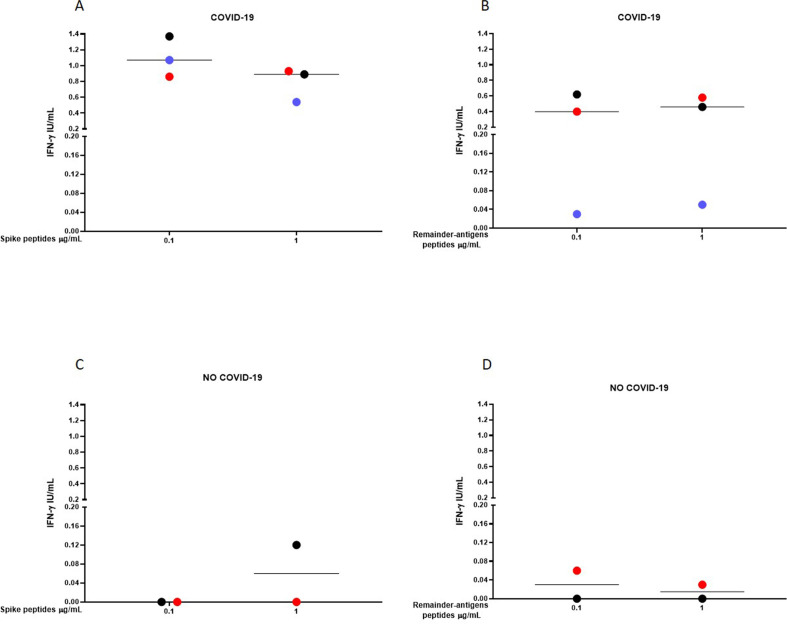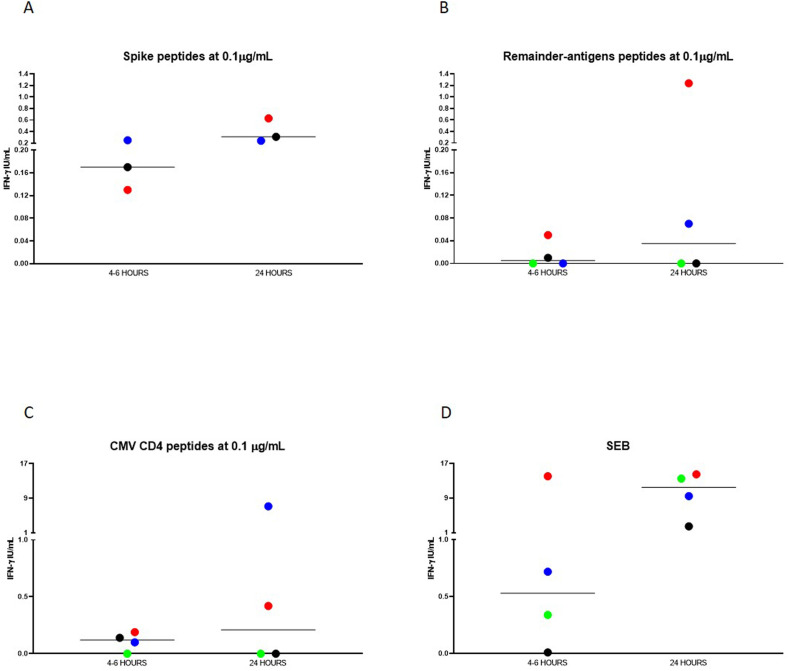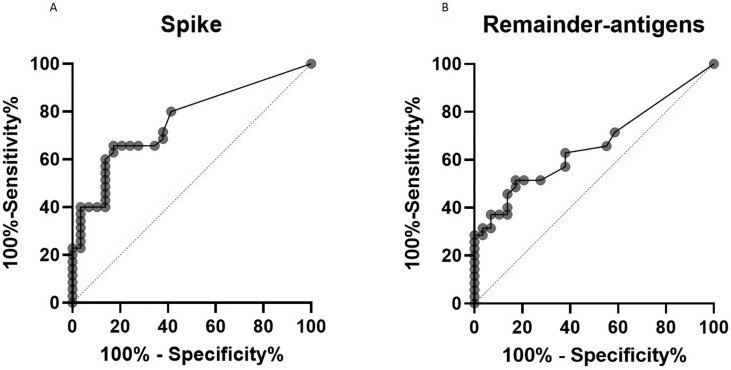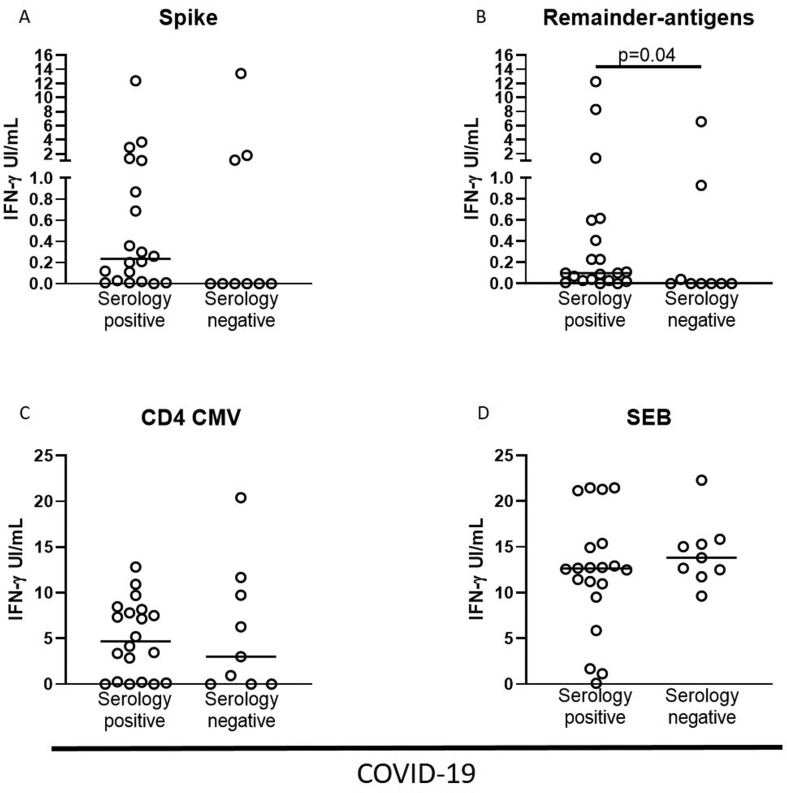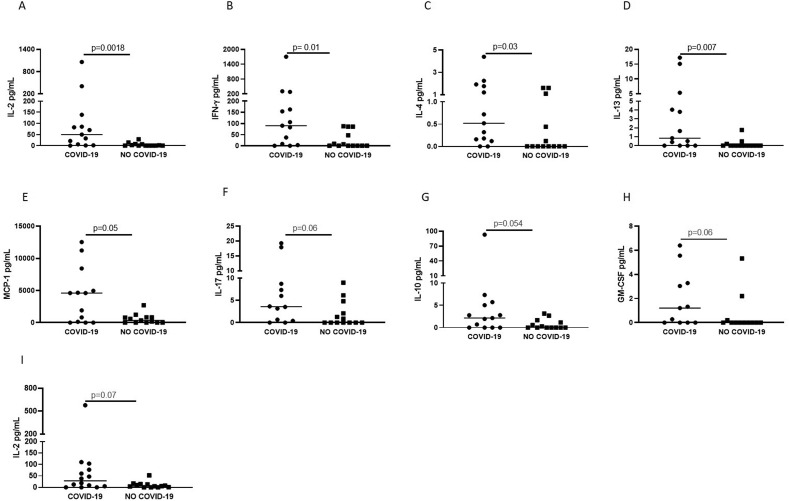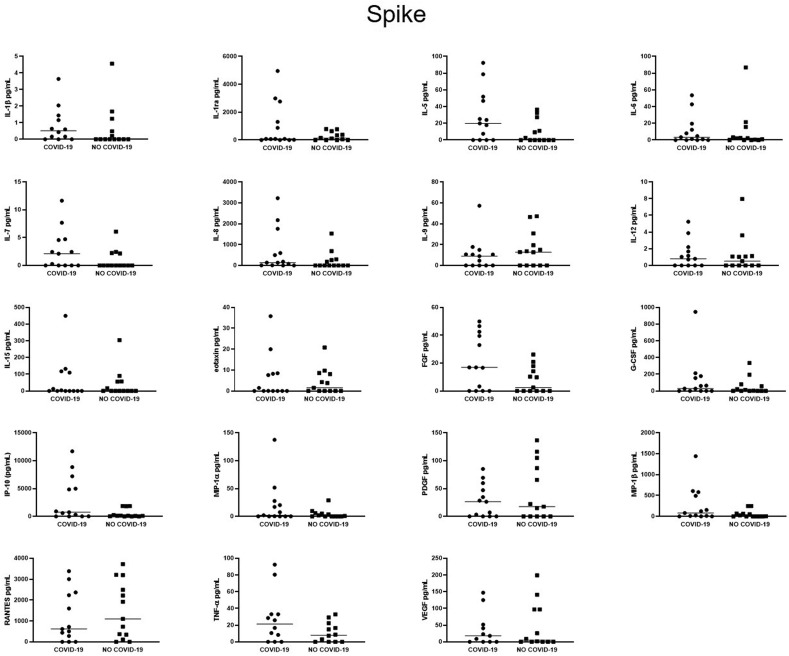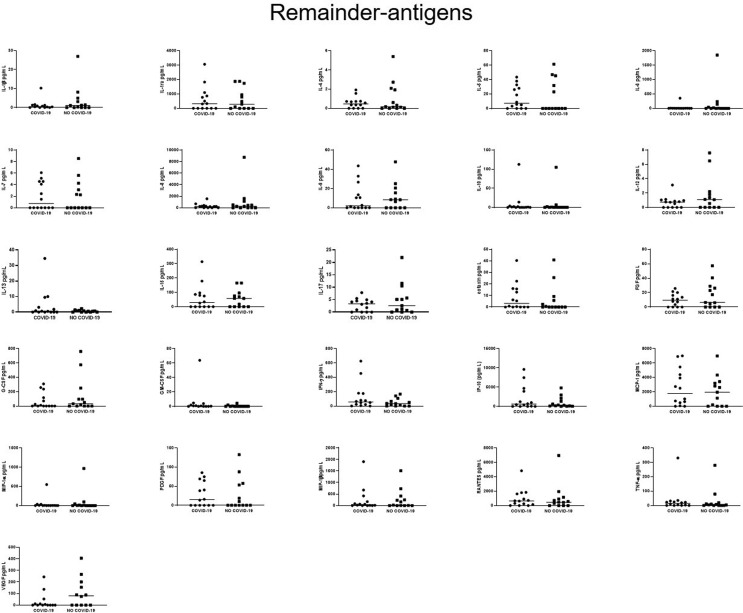Abstract
Objectives
To examine whether specific T-cell-responses to SARS-CoV-2 peptides can be detected in COVID-19 using a whole-blood experimental setting, which may be further explored as a potential diagnostic tool.
Methods
We evaluated interferon (IFN)-γ levels after stimulating whole-blood with spike and remainder-antigens peptides megapools (MP) derived from SARS-CoV-2 sequences; interleukin (IL)-1β, IL-1RA, IL-2, IL-4, IL-5, IL-6, IL-7, IL-8, IL-9, IL-10, IL-12p70, IL-13, IL-15, IL-17A, eotaxin, basic fibroblast growth factor (FGF), granulocyte-colony stimulating factor (G-CSF), granulocyte-macrophage colony-stimulating factor (GM-CSF), IFN-γ, Interferon gamma-induced protein 10 (IP-10), monocyte chemoattractant protein-1 (MCP-1), macrophage inflammatory protein (MIP)-1α, MIP-1β, Platelet-derived growth factor (PDGF), RANTES (regulated on activation, normal T cell expressed and secreted), tumour necrosis factor-alpha (TNF-α), vascular endothelial growth factor (VEGF) were also evaluated.
Results
IFN-γ-response to spike and remainder-antigens MPs was significantly increased in 35 COVID-19 patients compared with 29 ‘no COVID-19’ individuals (medians spike-MP: 0.26 vs 0, p = 0.0002; medians remainder-antigens-MP: 0.07 vs 0.02; p = 0.02).
This response was detected independently of patients' clinical parameters. IFN-γ-response to SARS-CoV-2-unrelated antigens cytomegalovirus (CMV) and Staphylococcal Enterotoxin B (SEB) was similar in COVID-19 compared with ‘no COVID-19’ individuals (median CMV: 3.46 vs 5.28, p = 0.16; median SEB: 12.68 vs 15.05; p = 0.1). In response to spike-MPs in COVID-19- compared with ‘no COVID-19’ -individuals, we found significant higher median of IL-2 (50.08 vs 0, p = 0.0018), IFN-γ (90.16 vs 0, p = 0.01), IL-4 (0.52 vs 0, p = 0.03), IL-13 (0.84 vs 0, p = 0.007) and MCP-1 (4602 vs 359.2, p = 0.05).
Conclusions
Immune response to SARS-CoV-2 peptides in a whole-blood assay is associated with COVID-19 and it is characterized by both Th1 and Th2 profile. This experimental approach may be useful for developing new T-cell based diagnostic tests for disease and vaccine settings.
Keywords: COVID-19, IFN-γ, Immune response, Multiplex analysis, SARS-CoV-2, Serology response, Specific response, T-cell based tests, Whole blood
Graphical abstract
Introduction
COVID-19 is an emerging respiratory infection caused by SARS-CoV-2 with an estimated global burden of more than 30 million [1]. Diagnosis is based on RT-PCR targeting one or more viral genes using nasopharyngeal swabs or other respiratory specimens [2]. High SARS-CoV-2-specific IgG-levels correlate with viral-neutralizing antibodies [3]. However, IgM/IgG-based tests may show cross-reactions with other coronaviruses [2].
SARS-CoV-2 infection is characterized by at least three main clinical presentations: absence of symptoms, mild/moderate disease, severe and critical disease [[4], [5], [6]]. Critically ill patients show a proinflammatory cytokine/chemokine storm [5] that contributes to the respiratory distress exacerbation; hence, several clinical studies aim to block the cytokine release. Increased production of inflammatory cytokines correlates with an impairment of both innate and adaptive cytotoxic antiviral functions [7]. Lymphopenia, another important feature of COVID-19, correlates to disease severity [8]. Moreover, transiently increased activated T-cells have been identified prior to symptoms resolution in non-severe diseased patients [9]. Regulatory and exhausted T-cells, as well as alterations in the memory T-cell subsets have also been recently reported in COVID-19 patients [10], as well as T-cell SARS-CoV-2-specific responses [[11], [12], [13], [14]]. Both CD4 and CD8 T-cells recognize peptides of SARS-CoV-2 antigens, such as the spike (S), membrane and nucleocapsid antigens. Responses were noted to large pools of peptides encompassing the sequence of the spike protein, or the remainder genome-encoded proteins. These responses were detected during the recovery [11] and the acute phase of disease [13].
T-cell-based tests have been explored in several infectious diseases including viral infections [[15], [16], [17], [18], [19], [20]] and cytokine-release-based tests in whole-blood are routinely or experimentally used for cytomegalovirus (CMV) infection monitoring [16], tuberculosis infection diagnosis [18] and have been explored for hepatitis B virus [15], toxoplasmosis [17] and cystic echinococcosis [19,20] diagnosis. This approach has not been scouted yet for SARS-CoV-2 infection.
Therefore, in this study we examined whether a whole-blood-based assay could be expanded to the detection of the SARS-CoV-2-specific T-cell responses in COVID-19 patients.
Material and method
Study population
Ethical Committee of Lazzaro Spallanzani National Institute of Infectious Diseases (INMI) approved the study (58/2020) that was conducted between 8 April 2020 and 1 July 2020. Informed, written consent was required to consecutively enroll patients and controls by physicians. The 35 COVID-19 patients (all with positive nasopharyngeal swab for SARS-CoV-2) were classified as mild, moderate, severe and critical, according to WHO [4]. For controls, 29 ‘no COVID-19’ -individuals were enrolled and were healthy donors (HDs) (n = 11) volunteers from our laboratory or a convenience sample of consecutively patients hospitalized for other diseases as bacterial pneumonia (n = 3), latent tuberculosis infection (n = 10), active tuberculosis under therapy (n = 4), echinococcosis (n = 1). Demographic and clinical information were collected at enrollment.
Stimuli
SARS-CoV-2 peptide pools (MegaPools, MPs) have been designed and validated [12,13,24]. The megapool design was carried out on the Wuhan-Hu-1 reference isolated (GenBank ID:MN908947). To ensure a comprehensive assessment of spike-specific reactivity, the main target of vaccine candidates, overlapping 15-mers by 10 spanning the entire protein were synthetized and pooled separately (spike; n = 253). The remainder of the SARS-CoV-2 proteome was filtered applying the seven-allele-method CD4-T-cell prediction [22] with a cutoff of ≤20, aiming to predict promiscuous epitopes with the capability to bind across the most common HLA-class II specificities (remainder-antigens; n = 221).
Peptides were synthesized as crude material (A&A, San Diego, CA, USA), resuspended in dimethyl-sulphoxide and pooled according to spike- or remainder-antigens-MP composition followed by sequential lyophilization steps [23].
A CMV-MP (n = 180) previously described [23], and Staphylococcal Enterotoxin B (SEB) positive control were included.
IFN-γ whole-blood-assay
Six hundred microlitres of whole-blood were stimulated or not with spike- or remainder-antigens-MP, CMV-MP as unrelated antigen and SEB as positive control. Plasma was harvested after 6/24 h of stimulation at 37°C (5% CO2) and stored at -80°C. IFN-γ levels were evaluated by ELISA, according to manufacturer's instructions (www.quantiFERON.com). IFN-γ values were subtracted from the unstimulated- or dimethyl-sulphoxide control-control. The detection limit of the test was 0.065 IU/mL.
IgG serology
SARS-CoV-2 IgG levels were measured by ELISA according to manufacturer's instructions (DIESSE Diagnostica Senese S.p.a., Monteriggioni, Italy). The ratio between the optical density of the sample and that of the cut-off reagent (index) has been calculated. The samples were scored positive (index >1.1), doubtful (index between 1.1 and 0.9), negative (index is < 0.9). In the ‘no COVID-19’ group, ELISA-positive samples were tested with an indirect immunofluorescence assay, using home-made slides prepared with SARS-CoV-2-infected Vero E6-cells.
Multiplex analysis
Cytokines, chemokines and growth factors [Interleukin (IL)-1β, IL-1RA, IL-2, IL-4, IL-5, IL-6, IL-7, IL-8, IL-9, IL-10, IL-12p70, IL-13, IL-15, IL-17A, eotaxin, basic fibroblast growth factor (FGF), granulocyte-colony stimulating factor (G-CSF), granulocyte-macrophage colony-stimulating factor (GM-CSF), IFN-γ, Interferon gamma-induced protein 10 (IP-10), monocyte chemoattractant protein-1 (MCP-1), macrophage inflammatory protein (MIP)-1α, MIP-1β, Platelet-derived growth factor (PDGF), RANTES (regulated on activation, normal T cell expressed and secreted), tumour necrosis factor-alpha (TNF-α), vascular endothelial growth factor (VEGF)] were evaluated in harvested plasma using Bio-Plex Pro Human Cytokine 27-plex Assay panel and the MagPix system (all from Bio-Rad, Hercules, CA, USA), according to manufacturer's instructions. Raw data were generated using the Bio-Plex Manager software. Concentrations below the detection range were considered as zero. Concentrations above the detection range were converted to the highest value of the standard curve. Analyte levels were subtracted from the unstimulated control. Samples with acquired beads count <50 were excluded from the final analysis.
Statistical analysis
Data were analysed using SPSS software (Version 19 for Windows, Italy SRL, Bologna, Italy), and Graph Pad (GraphPad Prism 8 XML ProjecT). Medians and interquartile ranges (IQRs) were calculated; the following tests were used: Kruskal–Wallis test for comparisons among groups, Mann–Whitney U-test with Bonferroni correction for pairwise comparisons, Chi-squared test for categorical variables; receiver-operator characteristic (ROC) analysis for evaluating diagnostic performance; Spearman Rank Correlation for correlations and rs > 0.7 was considered high correlation, 0.7 <rs >0.5 moderate correlation and rs < 0.5 low correlation.
Results
Description of the studied population
The COVID-19 group showed a significantly higher median age (p = 0.006) and a higher number of females compared with the ‘no COVID-19’ group (p = 0.23) (Table 1 ). COVID-19 patients were classified as mild (n = 9, 25.7%), moderate (n = 15, 42.9%), severe (n = 2, 5.7%) and critical (n = 9, 25.7%). SARS-CoV-2 IgG-serology results were available for 29 COVID-19 (83%) and for all ‘no COVID-19’ individuals (100%). Within the COVID-19 group, 20 (69%) scored SARS-CoV-2-serology-positive. One (HD) in the ‘no COVID-19’ group had a positive IgG-serology by ELISA not confirmed by immunofluorescence testing which showed an antibody pattern not SARS-CoV-2-specific. Therefore, all ‘no COVID-19’ individuals were considered SARS-CoV-2-serology-negative. IgG-serology testing and whole-blood-test were performed concomitantly (or within a week).
Table 1.
Demographical and clinical characteristics of the enrolled subjects
| COVID-19 | No COVID-19 | p | |
|---|---|---|---|
| n (%) | 35 | 29 | — |
| Age median (IQR) | 61 (51–76) | 50 (39–61) | 0.006 |
| Male, n (%) | 14 (40.0) | 16 (55.2) | 0.23 |
| Origin, n (%) | 0.78 | ||
| Western Europe | 26 (74.3) | 19 (65.6) | |
| Eastern Europe | 2 (5.7) | 2 (6.9) | |
| Asia | 3 (8.6) | 3 (10.3) | |
| Africa | 3 (8.6) | 2 (6.9) | |
| North America | 0 (0) | 0 (0) | |
| South America | 1 (2.8) | 3 (10.3) | |
| Swab positive results, n (%)∗ | 35 (100.0) | 0 (0) | <0.0001 |
| Serology results, n (%)§ | 0.0001 | ||
| Positive | 20 (69.0) | 0 (0) | |
| Negative | 9 (31.0) | 29 (100.0) | |
| Severity, n (%) | |||
| Mild | 9 (25.7) | — | |
| Moderate | 15 (42.9) | — | |
| Severe | 2 (5.7) | — | |
| Critical | 9 (25.7) | — | |
Origin refers to country of birth. IQR, interquartile range.
Information available from 35 COVID-19 (100%) and seven (24%) ‘no-COVID-19’ individuals.
Information available from 29 COVID-19 (83%) and 29 ‘no COVID-19’ (100%) individuals.
Whole-blood IFN-γ response to SARS-CoV-2 peptides is increased in COVID-19 compared with ‘no COVID-19’ individuals
Two different concentrations of spike- and remainder-antigens-MPs and two stimulation time points were tested (Supplementary Figs. S1 and S2). No significant differences were found in response to both spike- or remainder-antigens-MPs at the concentrations tested (0.1–1 μg/mL) neither in COVID-19 (Supplementary Fig. S1(a),(b)) nor in ‘no COVID-19’ individuals (Supplementary Fig. S1(c), (d)). A higher IFN-γ response after 24 h of stimulation for all stimuli compared with after 6 h was found (Supplementary Fig. S2). Following experiments were performed testing SARS-CoV-2 peptides at 0.1 μg/mL for 24-h stimulation.
IFN-γ response to spike-MP (median: 0.26, IQR: 0.01–1.37) was higher compared with remainder-antigens-MP (median: 0.07, IQR 0–0.62) (p = 0.18) in COVID-19 patients; ‘no COVID-19’ subjects showed a similar trend (spike-MP median: 0, IQR: 0–0.07; remainder-antigens-MP median: 0.02, IQR: 0–0.05, p = 0.53). Interestingly, IFN-γ levels in response to spike- and to remainder-antigens-MPs stimulations were significantly higher in COVID-19 compared with ‘no COVID-19’ individuals (p = 0.0002 and p = 0.02, respectively) (Fig. 1 (a), (b)). Importantly, no significant differences among the COVID-19 and ‘no COVID-19’ groups were found using SEB- (median: 12.68, IQR 11.22-15.03 vs median 15.05, IQR 12.58–17.50; p = 0.1) and CMV-stimulus (median: 3.46, IQR 0.14-8.47 vs median: 5.28, IQR 1.71-12.9; p = 0.16), employed as non-specific and -unrelated stimulation, respectively (Fig. 1(c), (d)). Within the ‘no COVID-19’ group, no significant differences were found comparing the IFN-γ response with all stimuli between HDs and the controls (p ≥ 0.32).
Fig. 1.
Increased interferon (IFN)-γ response to SARS-CoV-2 peptides is associated with COVID-19. IFN-γ levels are significantly increased in COVID-19 patients compared with ‘no COVID-19’ patients after stimulating whole-blood with spike- (a) or remainder-antigens- megapools (MPs) (b). IFN-γ levels in response to the unrelated antigens CMV (c) and SEB (d) are similar in COVID-19 and ‘no COVID-19’ groups. IFN-γ was measured by ELISA in stimulated plasma. The horizontal lines represent the median; statistical analysis was performed using the Mann–Whitney test, and p-value was considered significant when ≤0.05. Blue dots highlight healthy donors. CD, cluster of differentiation; CMV, cytomegalovirus; SEB, staphylococcal enterotoxin B.
An ROC analysis was performed to evaluate the accuracy of the test for the diagnosis of COVID-19 (Supplementary Fig. S3(a), (b)). Significant Area Under the Curve (AUC) results were obtained for both spike- (AUC 0.76, 95% confidence interval (CI) 0.64–0.88; p = 0.0004) and remainder-antigens-MP (AUC: 0.66, 95% CI 0.53–0.79; p = 0.03).
Based on the likelihood ratio, we defined the cut-off for scoring purposes (0.16 IU/mL for the IFN-γ response to spike-MP and 0.095 IU/mL for the remainder-antigens-MP) identifying, respectively, 60% and 46% as responders within the COVID-19 patients.
Whole-blood IFN-γ response to SARS-CoV-2 peptides is increased in COVID-19 patients with a positive SARS-CoV-2 IgG serology
IFN-γ levels in response to both spike- and remainder-antigens-MPs were increased in COVID-19 patients with a positive serology compared with those with a negative serology and the difference was significant for remainder-antigens-MP (p = 0.11 and p = 0.04, respectively) whereas no differences were found in response to SEB or CMV (p = 0.32 and p = 0.81, respectively) (Supplementary Fig. S4 (a)–(d)). COVID-19 patients with a positive or negative serology showed similar clinical characteristics as disease severity, lymphocyte counts, therapy (p ≥ 0.18) (data not shown). The correlation between IFN-γ levels in response to spike and remainder-antigens and the serology index was performed in 28 COVID-19- and 26 ‘no COVID-19′ individuals. A significant low correlation was found for both spike- (rs = 0.45, p = 0.0006) and remainder-antigens-MPs (rs = 0.37, p = 0.006) (data not shown).
Whole-blood IFN-γ response to SARS-CoV-2 peptides is detected independently of the disease severity, symptoms onset, and lymphocytes counts
Stratifying the COVID-19 patients based on disease severity, no significantly different IFN-γ levels were observed among patients with mild or moderate or severe/critical disease in response to both spike- (p = 0.27) (Fig. 2 (a)) and remainder-antigens-MPs (p = 0.72) (Fig. 2(b)). The impact of symptoms onset on the SARS-CoV-2 response was evaluated in 22/35 (62.9%) COVID-19 patients. IFN-γ levels were stratified considering the COVID-19 symptoms onset within 15 days, 16–30 days or more than 31 days and no significant differences were found neither for spike- (Fig. 2(c)) (p = 0.51) nor for remainder-antigens-MPs (Fig. 2(d)) responses (p = 0.78).
Fig. 2.
The interferon (IFN)-γ response to SARS-Cov-2 peptides can be detected independently of the disease severity and symptoms onset. Evaluation of the IFN-γ response to spike- (a) and to remainder-antigens-megapools (MPs) (b) in COVID-19 patients according to the severity of the disease. No significant differences in the IFN-γ levels were found comparing patients with mild or moderate or severe/critical illness. Evaluation of the IFN-γ response to spike- (c) and to remainder-antigens- MPs (d) in COVID-19 patients according to symptoms onset. No significant differences were found in the IFN-γ levels stratifying patients based on symptoms onset in respect to IFN-γ testing. IFN-γ was measured by ELISA in stimulated plasma. The horizontal lines represent the median; statistical analysis was performed using the Mann–Whitney test and p ≤ 0.016 was considered significant.
COVID-19 patients (29/35) were stratified based on ranges of lymphocyte absolute number: <1 × 103/μL; ≥1 × 103/μL <2 × 103/μL; >2 × 103/μL (Fig. 3(a)–(c)) and neither significant differences in the IFN-γ response to spike- (p = 0.55) and remainder-antigens-MPs (p = 0.70) nor correlations with lymphocyte counts were found (Fig. 3(d), (e)). The SEB response was robust especially in patients with more than 1 × 103/μL lymphocytes and a significant low correlation between IFN-γ levels and lymphocyte counts was found (rs = 0.37, p = 0.05) (Fig. 3(f)).
Fig. 3.
The interferon (IFN)-γ response to SARS-Cov-2 peptides can be detected independently on the number of lymphocytes. No significant differences were found in the IFN-γ levels in response spike- (a) and to remainder-antigens- megapools (MPs) (b) according to lymphocytes counts. The IFN-γ response to the Staphylococcal Enterotoxin B (SEB) (c) increases in patients with more than 1 × 103/μL lymphocytes. Correlation of the lymphocyte counts and IFN-γ levels in response to spike- (d), remainder-antigens-MPs (e) and SEB (f); a significant (p = 0.05) but low positive correlation (rs = 0.37) was found for SEB stimulation. IFN-γ was measured by ELISA in stimulated plasma. The horizontal lines represent the median; statistical analysis was performed using the Kruskall–Wallis test, Mann–Whitney test and Spearman's rank correlation test; p ≤ 0.05 or p ≤ 0.016 was considered significant.
Therapy was evaluated as a potential factor impacting the IFN-γ response to SARS-CoV-2 peptides; however, the studied population was too small to perform statistical analysis.
The whole-blood response to SARS-CoV-2 response is characterized by Th1 but also Th2 cytokines
The production of several cytokines, chemokines and growth factors was evaluated in 13 COVID-19 and 13 ‘no COVID-19’ individuals for spike-MP and 14 COVID-19 and 13 ‘no COVID-19’ individuals for remainder-antigens-MP enrolled within a week from swab results (median 4 days, IQR: 3–20 days). In response to spike-MP, significantly higher levels of: IL-2 (median 50.08, IQR 3.765–111.8 vs median 0, IQR 0–6.98, p = 0.0018), IFN-γ (median 90.16, IQR 5.7–222.5 vs median 0, IQR 0–66.68, p = 0.01), IL-4 (median 0.52, IQR 0.14–1.84 vs median 0, IQR 0–0.76, p = 0.03), IL-13 (median 0.84, IQR 0–4.720 vs median 0, IQR 0–0.1, p = 0.007), and MCP-1 (median 4602, IQR 65.66–6692 vs median 359.2, IQR 0–818.8, p = 0.05) were found in COVID-19- compared with ‘NO-COVID-19’ individuals (Supplementary Fig. S5(a)–(e)). A trend of high IL-17, IL-10 and GM-CSF levels was also found in COVID-19 patients (Supplementary Fig. S5(f)–(h)) compared with controls (p = 0.06, p = 0.054 and p = 0.06, respectively). Regarding remainder-antigens-MP, an increased IL-2 response in the COVID-19 group compared with the ‘no COVID-19’ group was found (p = 0.07) (Supplementary Fig. S5). No other differences neither in response to spike- nor to remainder-antigens-MPs (Supplementary Figs. S6 and S7) were found. No significant differences were found stratifying the cytokines levels based on SARS-CoV-2 IgG-serology scores (p ≥ 0.5). A significant moderate correlation was found between IgG index and the levels of IL-2 in response to spike-MP (rs = 0.58, p = 0.009) (data not shown).
Discussion
In this study, we showed the ability to detect T-cell response to SARS-CoV-2-specific peptides using a whole-blood-cytokine release assay. In particular, COVID-19 patients showed a significant high IFN-γ response, although both Th1 and Th2 cytokines were detected. Unrelated SARS-CoV-2-antigens induced a cytokine response independently of COVID-19 status, thus supporting the specificity of the immune response to viral-peptides. Moreover, the SARS-CoV-2-specific response was independent of the severity of the disease, symptoms onset and lymphocytes count. These results suggest that the whole-blood test for evaluating the T-cell response to SARS-CoV-2 may be a potential additional tool for further diagnostic and clinical deeper evaluations.
These immunological data are supported by recent findings showing a predominant Th1-response and by a concomitant Th2- and Th17-compartment in COVID-19 [10,13]. Th1-profile has been associated with disease resolution [24], whereas the Th17-cells may be crucial for immune-mediated tissue damage, mediating neutrophils recruitment and their activation in the lungs [10,25]. In COVID-19, we showed increased levels of IL-17 (almost significant) and MCP-1, both involved in the immune cells recruitment. These results suggest that COVID-19 is characterized by a broad immune activation with both inflammatory- and regulatory-arms involved, similar to bacterial sepsis [10].
Cytokine responses after MPs stimulations were found in few ‘no COVID-19’ -individuals. These data are in agreement with previous studies demonstrating a cross-reactivity of SARS-CoV-2 antigens in ‘no COVID-19’ -individuals induced by a past exposure to seasonal cold coronaviruses [[11], [12], [13],26]. Therefore, a more species-specific peptide selection is needed to fully understand the immune response to SARS-CoV-2.
A correlation between the B-cell and T-cell responses to SARS-CoV-2 antigens was found. Indeed, COVID-19 patients with negative SARS-CoV-2 serology showed a low IFN-γ response to the viral peptides. This result underlines the strict relationship between the two immune compartments in COVID-19 as in other viral diseases [18].
Limitations of this work are related to the low number of the patients evaluated within an observational-designed study preventing the full evaluation of the potentials of this immune-based approach for supporting COVID-19 diagnosis. A prospective study design including exposed-individuals followed over time and/or the enrollment of a large cohort of COVID-19 patients at different stages, will undoubtedly help addressing these issues. Also, we did not evaluate by cytometry or ELISPOT the cells responsible of the IFN-γ response to the SARS-CoV-2 MPs. These peptides were previously designed to capture SARS-CoV-2-specific CD4 T-cell response and showed indeed a strong SARS-CoV-2-CD4-specific as well as a SARS-CoV-2-CD8-specific response in the context of the spike pool protein [11,13,21]. Therefore, this characterization was beyond the scope of this pilot study. Here, we aimed to measure the total T-cell response considering that T-cells in whole-blood are the main source of IFN-γ, even if other cell types (e.g., natural killer cells, B-lymphocytes) may be involved. Nevertheless, a strength of this study was its verification of the ability of SARS-CoV-2 peptides to induce an immune response in a whole-blood in vitro system. Thus, this study offers hints for developing rapid T-cell-based assays for SARS-CoV-2 infection. Cytokine release-based tests are considered easy and valid tools for the diagnosis of several infectious diseases [[15], [16], [17], [18], [19], [20]]. Moreover, whole-blood tests showed a good correlation with other experimental approaches involving peripheral blood mononuclear cell stimulation [[28], [29], [30]] which underlines their analytical robustness. Considering that SARS-CoV-2-IgG levels are not constant over time [2,27], the development of a new diagnostic T-cell-based assay may support COVID-19 diagnosis. Moreover, this approach may be applied in several scenarios including the immune response monitoring in vaccine trials.
In conclusion, our encouraging preliminary results show that the response to SARS-CoV-2 peptides can be detected in whole-blood and is characterized by Th1 and Th2 profiles.
Transparency declaration
A.G. is listed as inventor on a provisional patent application on the diagnostic and therapeutic use of the MPs and peptides thereof filed on 12 February 2020. There are no conflicts of interest to declare for any of the other authors. This work was supported by Line one-Ricerca Corrente "Infezioni Emergenti e Riemergenti", by Line four-Ricerca Corrente and by the projects COVID 2020 12371675 and COVID-2020-12371735, all funded by Italian Ministry of Health.
Acknowledgements
The authors wish to acknowledge Alessandro Sette and Daniela Weiskopf for helpful discussions and providing peptide reagents. Moreover, the authors are grateful to all the patients and nurses who helped to conduct this study. The authors gratefully acknowledge the Collaborators Members of the National Institute for Infectious Diseases (INMI) COVID-19 study group: Maria Alessandra Abbonizio, Amina Abdeddaim, Chiara Agrati, Fabrizio Albarello, Gioia Amadei, Alessandra Amendola, Andrea Antinori, Mario Antonini, Tommaso Ascoli Bartoli, Francesco Baldini, Raffaella Barbaro, Barbara Bartolini, Rita Bellagamba, Martina Benigni, Nazario Bevilacqua, Gianlugi Biava, Michele Bibas, Licia Bordi, Veronica Bordoni, Evangelo Boumis, Marta Branca, Donatella Busso, Marta Camici, Paolo Campioni, Maria Rosaria Capobianchi, Alessandro Capone, Cinzia Caporale, Emanuela Caraffa, Ilaria Caravella, Fabrizio Carletti, Concetta Castilletti, Adriana Cataldo, Stefano Cerilli, Carlotta Cerva, Roberta Chiappini, Pierangelo Chinello, Carmine Ciaralli, Stefania Cicalini, Francesca Colavita, Angela Corpolongo, Massimo Cristofaro, Salvatore Curiale, Alessandra D'Abramo, Cristina Dantimi, Alessia De Angelis, Giada De Angelis, Maria Grazia De Palo, Federico De Zottis, Virginia Di Bari, Rachele Di Lorenzo, Federica Di Stefano, Gianpiero D'Offizi, Davide Donno, Francesca Faraglia, Federica Ferraro, Lorena Fiorentini, Andrea Frustaci, Matteo Fusetti, Vincenzo Galati, Roberta Gagliardini, Paola Gallì, Gabriele Garotto, Saba Gebremeskel Tekle, Maria Letizia Giancola, Filippo Giansante, Emanuela Giombini, Guido Granata, Maria Cristina Greci, Elisabetta Grilli, Susanna Grisetti, Gina Gualano, Fabio Iacomi, Giuseppina Iannicelli, Giuseppe Ippolito, Eleonora Lalle, Simone Lanini, Daniele Lapa, Luciana Lepore, Raffaella Libertone, Raffaella Lionetti, Giuseppina Liuzzi, Laura Loiacono, Andrea Lucia, Franco Lufrani, Manuela Macchione, Gaetano Maffongelli, Alessandra Marani, Luisa Marchioni, Andrea Mariano, Maria Cristina Marini, Micaela Maritti, Alessandra Mastrobattista, Giulia Matusali, Valentina Mazzotta, Paola Mencarini, Silvia Meschi, Francesco Messina, Annalisa Mondi, Marzia Montalbano, Chiara Montaldo, Silvia Mosti, Silvia Murachelli, Maria Musso, Emanuele Nicastri, Pasquale Noto, Roberto Noto, Alessandra Oliva, Sandrine Ottou, Claudia Palazzolo, Emanuele Pallini, Fabrizio Palmieri, Carlo Pareo, Virgilio Passeri, Federico Pelliccioni, Antonella Petrecchia, Ada Petrone, Nicola Petrosillo, Elisa Pianura, Carmela Pinnetti, Maria Pisciotta, Silvia Pittalis, Agostina Pontarelli, Costanza Proietti, Vincenzo Puro, Paolo Migliorisi Ramazzini, Alessia Rianda, Gabriele Rinonapoli, Silvia Rosati, Martina Rueca, Alessandra Sacchi, Alessandro Sampaolesi, Francesco Sanasi, Carmen Santagata, Alessandra Scarabello, Silvana Scarcia, Vincenzo Schininà, Paola Scognamiglio, Laura Scorzolini, Giulia Stazi, Fabrizio Taglietti, Chiara Taibi, Roberto Tonnarini, Simone Topino, Francesco Vaia, Francesco Vairo, Maria Beatrice Valli, Alessandra Vergori, Laura Vincenzi, Ubaldo Visco-Comandini, Serena Vita, Pietro Vittozzi, and Mauro Zaccarelli. Delia Goletti is a professor of Pathology of Unicamillus, International Medical University of Rome.
Editor: F. Allerberger
Footnotes
Supplementary data to this article can be found online at https://doi.org/10.1016/j.cmi.2020.09.051.
Author contributions
L.P. analysed and interpreted data, performed the multiplex cytokine analysis and wrote the manuscript; E.P. analysed and interpreted data and wrote the manuscript; V.V. processed blood samples and performed the IFN-γ ELISA; G.C. enrolled patients and controls and collected clinical data; S.N.F. performed multiplex cytokine analysis; C.C. performed SARS-CoV-2 serology and contributed to the interpretation of the results; T.A. participated in the interpretation of data; F.P., G.G., P.V., E.N., L.L., A.A., A.V. enrolled patients; N.C., F.C., E.G., G.I. participated in the interpretation of data; A.G. provided peptide reagents and participated in the interpretation of data; D.G. designed and wrote the study, coordinated and supervised the project, contributed to the interpretation of the results, wrote the manuscript. All authors approved the final version of the manuscript.
Appendix A. Supplementary data
The following are the Supplementary data to this article:
Figs1.
Figs2.
Figs3.
Figs4.
Figs5.
Figs6.
Figs7.
References
- 1.ECDC. Report on COVID-19 pandemic. 2020. https://www.ecdc.europa.eu/en/covid-19-pandemic [Google Scholar]
- 2.Sethuraman N., Jeremiah S.S., Ryo A. Interpreting diagnostic tests for SARS-CoV-2. JAMA. 2020;323:2249–2251. doi: 10.1001/jama.2020.8259. [DOI] [PubMed] [Google Scholar]
- 3.To K.K., Tsang O.T., Leung W.S., Tam A.R., Wu T.C., Lung D.C. Temporal profiles of viral load in posterior oropharyngeal saliva samples and serum antibody responses during infection by SARS-CoV-2: an observational cohort study. Lancet Infect Dis. 2020;20:565–574. doi: 10.1016/S1473-3099(20)30196-1. [DOI] [PMC free article] [PubMed] [Google Scholar]
- 4.WHO . Vol. 2020. 2020. Clinical management of COVID-19. Interim guidance. [Google Scholar]
- 5.Huang C., Wang Y., Li X., Ren L., Zhao J., Hu Y. Clinical features of patients infected with 2019 novel coronavirus in Wuhan, China. Lancet. 2020;395:497–506. doi: 10.1016/S0140-6736(20)30183-5. [DOI] [PMC free article] [PubMed] [Google Scholar]
- 6.Nicastri E., Petrosillo N., Ascoli Bartoli T., Lepore L., Mondi A., Palmieri F. National Institute for the infectious diseases "L. Spallanzani", IRCCS. Recommendations for COVID-19 clinical management. Infect Dis Rep. 2020;12:8543. doi: 10.4081/idr.2020.8543. [DOI] [PMC free article] [PubMed] [Google Scholar]
- 7.Bordoni V., Sacchi A., Cimini E., Notari S., Grassi G., Tartaglia E. An inflammatory profile correlates with decreased frequency of cytotoxic cells in COVID-19. Clin Infect Dis. 2020;15:ciaa577. doi: 10.1093/cid/ciaa577. [DOI] [PMC free article] [PubMed] [Google Scholar]
- 8.Tan L., Wang Q., Zhang D., Ding J., Huang Q., Tang Y.Q. Lymphopenia predicts disease severity of COVID-19: a descriptive and predictive study. Signal Transduct Target Ther. 2020;5:33. doi: 10.1038/s41392-020-0148-4. [DOI] [PMC free article] [PubMed] [Google Scholar]
- 9.Xu Z., Shi L., Wang Y., Zhang J., Huang L., Zhang C. Pathological findings of COVID-19 associated with acute respiratory distress syndrome. Lancet Respir Med. 2020;8:420–422. doi: 10.1016/S2213-2600(20)30076-X. [DOI] [PMC free article] [PubMed] [Google Scholar]
- 10.De Biasi S., Meschiari M., Gibellini L., Bellinazzi C., Borella R., Fidanza L. Marked T cell activation, senescence, exhaustion and skewing towards TH17 in patients with COVID-19 pneumonia. Nat Commun. 2020;11:3434. doi: 10.1038/s41467-020-17292-4. [DOI] [PMC free article] [PubMed] [Google Scholar]
- 11.Grifoni A., Weiskopf D., Ramirez S.I., Mateus J., Dan J.M., Moderbacher C.R. Targets of T cell responses to SARS-CoV-2 Coronavirus in humans with COVID-19 disease and unexposed individuals. Cell. 2020;181:1489–1501.e15. doi: 10.1016/j.cell.2020.05.015. [DOI] [PMC free article] [PubMed] [Google Scholar]
- 12.Le Bert N., Tan A.T., Kunasegaran K., Tham C.Y.L., Hafezi M., Chia A. SARS-CoV-2-specific T cell immunity in cases of COVID-19 and SARS, and uninfected controls. Nature. 2020;584:457–462. doi: 10.1038/s41586-020-2550-z. [DOI] [PubMed] [Google Scholar]
- 13.Weiskopf D., Schmitz K.S., Raadsen M.P., Grifoni A., Okba N.M.A., Endeman H. Phenotype and kinetics of SARS-CoV-2-specific T cells in COVID-19 patients with acute respiratory distress syndrome. Sci Immunol. 2020;5 doi: 10.1126/sciimmunol.abd2071. [DOI] [PMC free article] [PubMed] [Google Scholar]
- 14.Sekine T., Perez-Potti A., Rivera-Ballesteros O., Strålin K., Gorin J.B., Olsson A. Robust T cell immunity in convalescent individuals with asymptomatic or mild COVID-19. Cell. 2020 doi: 10.1016/j.cell.2020.08.017. [DOI] [PMC free article] [PubMed] [Google Scholar]
- 15.Dammermann W., Bentzien F., Stiel E.M., Kühne C., Ullrich S., Schulze Zur Wiesch J. Development of a novel IGRA assay to test T cell responsiveness to HBV antigens in whole blood of chronic Hepatitis B patients. J Transl Med. 2015;13:157. doi: 10.1186/s12967-015-0513-1. [DOI] [PMC free article] [PubMed] [Google Scholar]
- 16.Kim S.H. Interferon-γ release assay for cytomegalovirus (IGRA-CMV) for risk stratification of posttransplant CMV infection: is it time to apply IGRA-CMV in routine clinical practice? Clin Infect Dis. 2020:ciz1211. doi: 10.1093/cid/ciz1211. [DOI] [PubMed] [Google Scholar]
- 17.Mahmoudi S., Mamishi S., Suo X., Keshavarz H. Early detection of Toxoplasma gondii infection by using a interferon gamma release assay: a review. Exp Parasitol. 2017;172:39–43. doi: 10.1016/j.exppara.2016.12.008. [DOI] [PubMed] [Google Scholar]
- 18.Min Ong C.W., Migliori G.B., Raviglione M., MacGregor-Skinner G., Sotgiu G., Alffenaar J.W. Epidemic and pandemic viral infections: impact on tuberculosis and the lung. A consensus by the world association for infectious diseases and immunological disorders (WAidid), global tuberculosis network (GTN) and members(#) of ESCMID study group for mycobacterial infections (ESGMYC) Eur Respir J. 2020:2001727. doi: 10.1183/13993003.01727-2020. [DOI] [PMC free article] [PubMed] [Google Scholar]
- 19.Petrone L., Vanini V., Amicosante M., Corpolongo A., Gomez Morales M.A., Ludovisi A. A T-cell diagnostic test for cystic echinococcosis based on Antigen B peptides. Parasite Immunol. 2017;39:e12499. doi: 10.1111/pim.12499. [DOI] [PMC free article] [PubMed] [Google Scholar]
- 20.Petrone L., Albrich W.C., Tamarozzi F., Frischknecht M., Gomez-Morales M.A., Teggi A. Species specificity preliminary evaluation of an IL-4-based test for the differential diagnosis of human echinococcosis. Parasite Immunol. 2020;42 doi: 10.1111/pim.12695. [DOI] [PMC free article] [PubMed] [Google Scholar]
- 21.Grifoni A., Sidney J., Zhang Y., Scheuermann R.H., Peters B., Sette A. A Sequence homology and bioinformatic approach can predict candidate targets for immune responses to SARS-CoV-2. Cell Host Microbe. 2020;27:671–680.e2. doi: 10.1016/j.chom.2020.03.002. [DOI] [PMC free article] [PubMed] [Google Scholar]
- 22.Paul S., Lindestam Arlehamn C.S., Scriba T.J., Dillon M.B., Oseroff C., Hinz D. Development and validation of a broad scheme for prediction of HLA class II restricted T cell epitopes. J Immunol Methods. 2015;422:28–34. doi: 10.1016/j.jim.2015.03.022. [DOI] [PMC free article] [PubMed] [Google Scholar]
- 23.Carrasco Pro S., Sidney J., Paul S., Lindestam Arlehamn C., Weiskopf D., Peters B. Automatic generation of validated specific epitope sets. J Immunol Res. 2015;2015:763461. doi: 10.1155/2015/763461. [DOI] [PMC free article] [PubMed] [Google Scholar]
- 24.Wei L.L., Wang W.J., Chen D.X., Xu B. Dysregulation of the immune response affects the outcome of critical COVID-19 patients. J Med Virol. 2020 doi: 10.1002/jmv.26181. [DOI] [PMC free article] [PubMed] [Google Scholar]
- 25.Iwanaga N., Kolls J.K. Updates on T helper type 17 immunity in respiratory disease. Immunology. 2019;156:3–8. doi: 10.1111/imm.13006. [DOI] [PMC free article] [PubMed] [Google Scholar]
- 26.Sette A., Crotty S. Pre-existing immunity to SARS-CoV-2: the knowns and unknowns. Nat Rev Immunol. 2020;20:457–458. doi: 10.1038/s41577-020-0389-z. [DOI] [PMC free article] [PubMed] [Google Scholar]
- 27.Xiao A.T., Gao C., Zhang S. Profile of specific antibodies to SARS-CoV-2: the first report. J Infect. 2020;81:147–178. doi: 10.1016/j.jinf.2020.03.012. [DOI] [PMC free article] [PubMed] [Google Scholar]
- 28.Chiacchio T., Delogu G., Vanini V., Cuzzi G., De Maio F., Pinnetti C. Immune characterization of the HBHA-specific response in Mycobacterium tuberculosis-infected patients with or without HIV infection. PLoS One. 2017;12 doi: 10.1371/journal.pone.0183846. [DOI] [PMC free article] [PubMed] [Google Scholar]
- 29.Goletti D., Vincenti D., Carrara S., Butera O., Bizzoni F., Bernardini G. Selected RD1 peptides for active tuberculosis diagnosis: comparison of a gamma interferon whole-blood enzyme-linked immunosorbent assay and an enzyme-linked immunospot assay. Clin Diagn Lab Immunol. 2005;12:1311–1316. doi: 10.1128/CDLI.12.11.1311-1316.2005. [DOI] [PMC free article] [PubMed] [Google Scholar]
- 30.Petrone L., Vanini V., Petruccioli E., Ettorre G.M., Schinina V., Busi Rizzi E. Polyfunctional specific response to Echinococcus Granulosus associates to the biological activity of the cysts. PLoS Negl Trop Dis. 2015;9 doi: 10.1371/journal.pntd.0004209. [DOI] [PMC free article] [PubMed] [Google Scholar]







